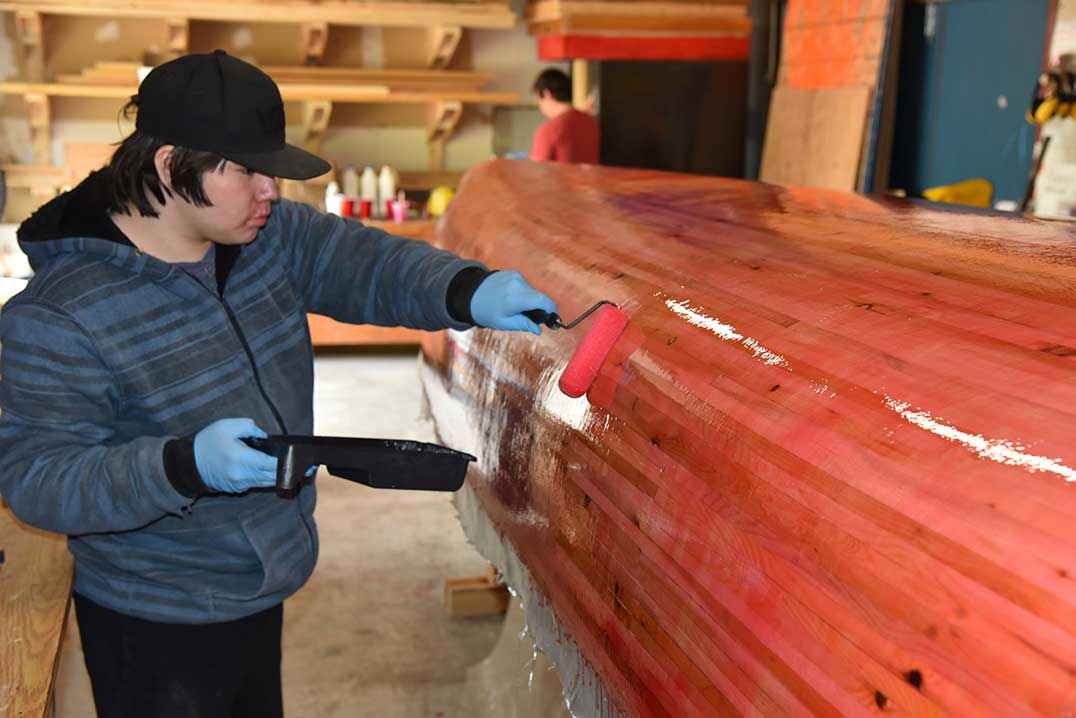WIIKWEMKOONG – Industrious students from Wikwemikong High School (WHS) are well underway on the construction of the largest “North” (also known as voyageur) canoe ever built on Manitoulin Island and the first-ever canoe build of its kind at the school, a project that has taken well over 30 hours of student work to date.
“We’ve really tried to ensure that this is all hands-on and done by the students,” said outdoor education teacher Nimkii Lavell. “You can see a lot of the positivity going into this; people are always stopping by and rubbing their hands on the hull.”
This project has involved the assistance of By Path or Paddle’s Mark Gibeault and the insight of paddler and canoe builder Rob Mellan. Mr. Mellan is the retired wilderness survival instructor for the Ontario Provincial Police and is an avid paddle racer.
By Path or Paddle has helped to provide the tools, expertise and materials needed to build the paddle, but WHS principal Maureen Peltier said the school has since purchased all the tools to build a North canoe on its own for next year.
The canoe has been coming together in a remarkably short span of time. The build started on March 26; by May 6 the hull was sanded smooth and nearly complete.

“These are the same types and shapes of the canoes that would have been paddling past these waters on the traditional Voyageur route from the French River to Killarney and the North Shore,” Mr. Lavell said.
“This is a very concrete example of the outdoor expertise of Anishinaabe people and the cultural resilience of the Anishinabek, in that these boats are essentially unchanged in form since the time of first contact.”
Student Mandaago Osawamick said he could feel the cultural significance of the build from an early stage.
“It gives a sense of who our people are and what we used to do. I hope they continue to do this in the future, it’s a good project,” said Mandaago.
Evanson Peltier is another student who has helped to construct the canoe. He agreed that he often feels culturally disconnected but that this project is a powerful antidote to those sentiments.
“It’s kind of stress-relieving. It has to do with our people from back then when they used to build canoes,” he said. “It feels therapeutic to me.”
Mandaago added that there was a special sense of satisfaction that came from seeing the hours of hard work amount to a finished product.
The canoe itself is made of roughly 170 strips of white cedar, a quarter of an inch thick, that are each between 12 and 18 feet in length. Mr. Lavell said these boats have previous been designed to carry 3,000 pounds of cargo and can accommodate 10 students comfortably, eight strong paddlers if speed is the ultimate goal and an absolute maximum of 12 students.
Despite the massive capacity of the boat, it’s only expected to weigh about 200 pounds in total—a weight shared by all the paddlers when portaging or carrying it to its next destination. The project is teaching the students about sustainable construction and economic activities and Mr. Lavell said he hopes it will show the students and others that, much like their recent successes in robotics competitions, First Nations people have an equal ability for science, technology and engineering tasks as any other group.
“And more importantly for outdoor education, this is an example of how hard work and perseverance pays off in accomplishing goals,” said Mr. Lavell. “If you want to paddle, you’ve got to build it first!”
Outdoor education is a Grade 11 course at WHS but also incorporates students from other grade levels. It is taught concurrently with a Native studies course so students receive a full morning of activities in either of the two areas. This enables them to better plan around inclement weather and offers more time to dive into projects.
“There’s more time to engage in land-based activities in a meaningful fashion,” Mr. Lavell said.
The year-end project for the outdoor education class is a multi-day canoe trip. Although the class is working hard to finish their canoe in time for the trip, Mr. Lavell said that the students will still get the chance to take a trip in a different boat in a worst-case scenario.
“We plan to explore the islands adjacent to Wiikwemkoong as an exploration of our traditions and culture, and also an assertion of our sovereignty of the places in our ongoing land claim,” said Mr. Lavell.
Wiikwemkoong is known for having rich marine heritage and community elders often stop by to see the boat under construction and discuss the area’s history.
Ms. Peltier said one concern was whether a boat of this size would even be able to fit out of the workshop when the project was finished. She described that the first step in the process was to build a rough wooden model that matched the dimensions of the finished product. Once they determined it would indeed make it out of the building, the real construction could begin.
The finished boat will be coated with fibreglass and epoxy, with the inside offering a clear coating so the paddlers will be able to admire the handiwork of the original construction team.